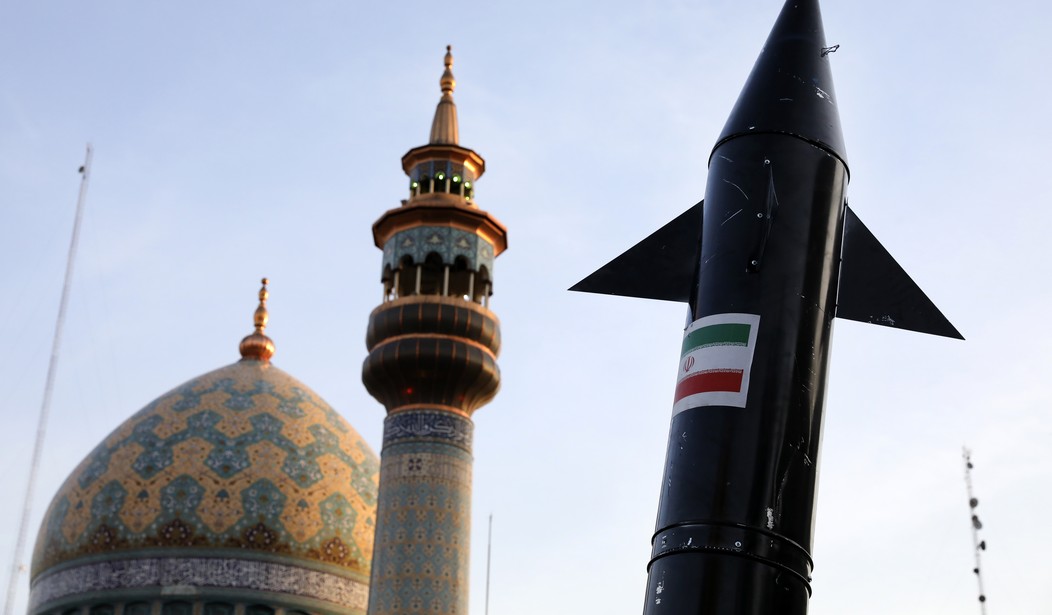In limited wars, every battle is fought twice. The first is the military side, the battle itself. Then comes the struggle over the narrative, over what the battle means. And this part is every bit as important as the kinetic phase because this is where victory can be turned into defeat.
We are seeing this play out in the wake of Iran's weekend missile and drone barrage on Israel. By every military metric, it was a complete failure. But on the level of the narrative, Tehran's apologists are trying to pull out a win.
Iran launched Operation True Promise as a vengeance strike against Israel for taking out Brigadier General Mohammad Reza Zahedi, a senior Quds Force commander of the Islamic Revolutionary Guard Corps. He was killed along with other IRGC officers in an April 1 raid on the Iranian consulate annex next to Iran’s embassy in Damascus, Syria.
Iran launched around 300 weapons from locations in Iran, Syria, and Yemen, including over 110 medium-range ballistic missiles, more than 30 land-attack cruise missiles, and over 150 uncrewed aerial vehicles. They targeted Israeli cities and military installations.
The numbers tell us this was a concerted attack, a major effort by Iran to inflict pain on Israel. But a coalition of countries including the United States, Jordan, the United Kingdom, France, and Saudi Arabia scrambled to support Israel and blunt the blow. Only a few of the incoming Iranian weapons got through, and they did little material damage. There was only one reported casualty, seven-year-old Amina Hassouna, who was seriously injured when debris from an intercepted ballistic missile struck her on the head at her family’s home in a Bedouin village in the southern Negev.
After the attack, Iran’s U.N. mission in New York claimed victory on X and said that the “matter can be deemed concluded,” which it most certainly is not.
So in sum, Israel’s air defenses, combined with a variety of joint Coalition countermeasures, downed a complex mix of three hundred attacking missiles and drones, securing Israel from a major Iranian effort to inflict harm on the Jewish State. A major victory, right?
Not so fast says the New York Times.
In an after-action analysis, the Times sought to pull defeat from the jaws of victory. In it, we learned that Iran’s attack failed because Iran wanted it to fail. Tehran did not use its best or most effective weapons because it only wanted to send a message. The attack “seemed designed to create maximum drama while inflicting minimal damage,” according to unnamed defense officials and military experts, including sources in the IRGC.
The Times claimed that Iran “sequenced the attack… in such a way that both Israelis and Americans were able to adjust their aerial defenses once the Iranian missiles and drones were in the air.” And “military experts and defense officials” said that the “inaccuracy level” of the Iranian weapons was “probably by design.”
So according to this narrative, whatever happened was not due to Israeli and Coalition technological readiness and warfighting prowess. Instead, events all unfolded according to Tehran’s cunning plan. There was no real threat to Israel because, as the Times said, the attack was not an attack but “a highly choreographed spectacle.” Since by this reasoning all Tehran was doing was sending a message, it was irrelevant whether the strikes were successful or not. This was just a big fireworks display over Israel courtesy of the Islamic Republic.
Journalists have been rationalizing enemy failures to hand them wins at least since the Vietnam War. This is how the United States lost the narrative struggle over the Tet Offensive. In 1968 the North Vietnamese and the Viet Cong mounted a major military offensive seeking to foment a mass uprising in South Vietnam to drive the Americans out of the country and win the war. However, the communists completely miscalculated the reaction of the South Vietnamese people as well as the rapid and devastating response of United States and South Vietnamese forces, so the Tet Offensive became a significant military disaster for Hanoi.
Enter journalism. The offensive was recast as a successful attempt by the Communists to “send a message,” i.e., another “highly choreographed spectacle,” which allowed opponents of the U.S. war effort to declare a communist victory. This is the Tet narrative that has been embedded ever since.
We saw the same dynamic with the 1968 siege of Khe Sanh, in which a small force of determined Marines held off a vastly larger North Vietnamese attack force, reminiscent of the stand of the 101st Airborne at Bastogne in World War II. But according to Walter Cronkite, Khe Sanh wasn’t surviving because of a dogged, well-executed, and heroic defense but because the North wasn’t trying very hard. “I found few people out there who really believe Khe Sanh could be held if the North Vietnamese were determined to take it,” he reported.
But of course, the North Vietnamese were determined to take Khe Sanh. More than 10,000 estimated communist troop deaths proved that. However, characterizing the outcome of the battle as optional for Hanoi made meaningful victory impossible because reporters could simply say the enemy could have won but chose not to.
That is the New York Times take on Iran, that they never intended to inflict damage on Israel. Tehran wisely sidestepped escalation by attacking in such a way that it knew Israel and the Coalition could intercept their weapons. It was a ballroom dance ingeniously choreographed by Iranian masterminds to avoid an escalatory spiral. But – as Tehran warned — next time it will attack for real, so watch out.
Imagine if those 300 Iranian weapons had gotten through. It would have been reported as a major Iranian victory, a devastating blow against Israel heralding Iran’s emergence as a true regional hegemon, signaling the end of Israel’s military influence and reshaping the map of the Middle East. That’s what an actual Iranian win would have looked like.
But since Tehran so abjectly failed, since their vaunted missile and drone force was singularly ineffective, since Iran was thoroughly humiliated on the world stage, it is up to narrative-based journalism to hand the aggressors an unearned victory yet again.









Join the conversation as a VIP Member